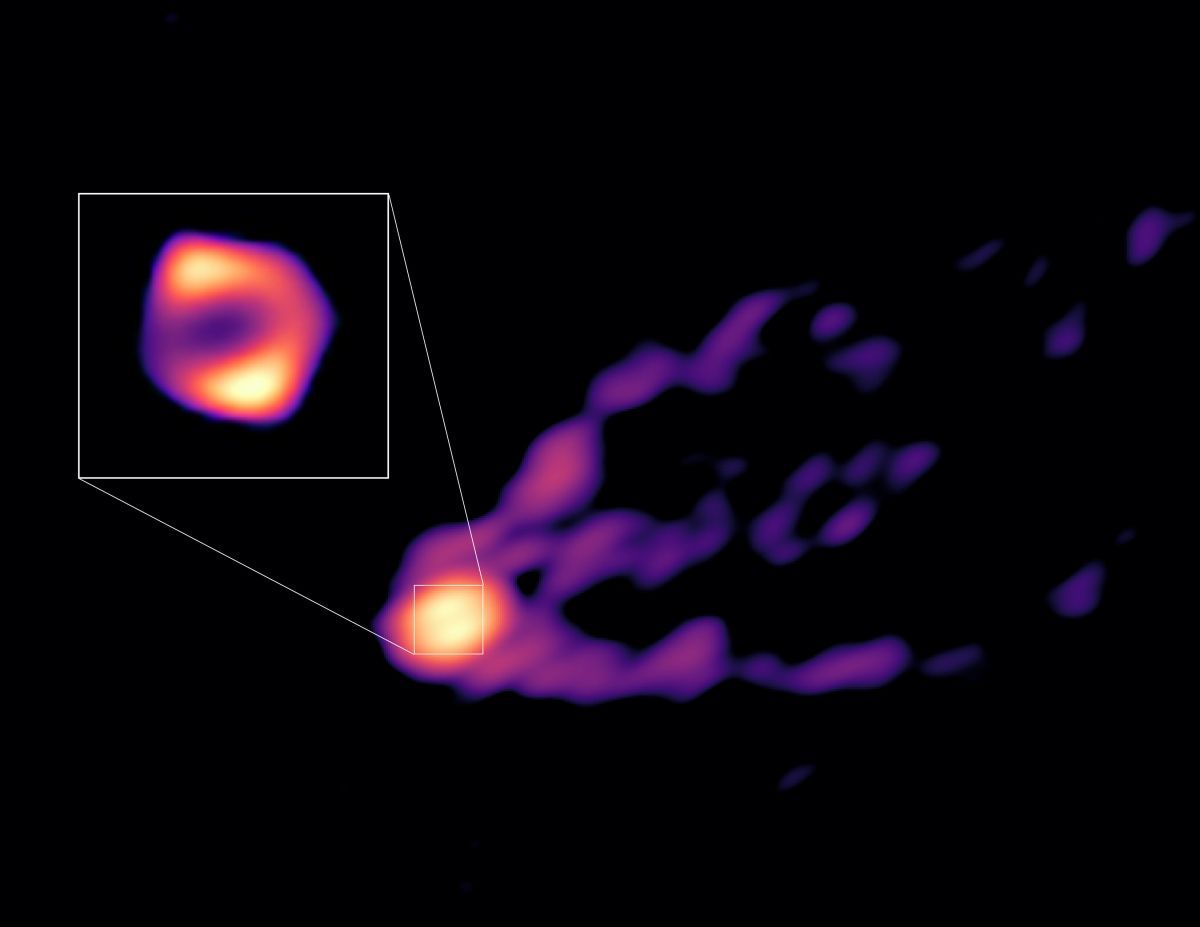Astronomers snap 1st direct image of black hole blasting out a jet
Astronomers have captured the first direct image of a black hole as it blasts out a powerful jet.
The new photo features the monstrous supermassive black hole at the heart of the galaxy Messier 87 (M87), the first black hole ever directly imaged by humanity .
The image shows precisely for the first time how the base of such an astrophysical jet moving at speeds approaching that of light connects to matter swirling around a supermassive black hole before being fed to its surface, a process astronomers call accretion. Previous images of M87's central black hole had managed to capture the jet it emits and the supermassive black hole itself, but not the two features together.
"This new image completes the picture by showing the region around the black hole and the jet at the same time," study team member Jae-Young Kim, of Kyungpook National University in South Korea and the Max Planck Institute for Radio Astronomy, said in a statement (opens in new tab) .
Related: Black holes of the universe (images)
An image of a powerful jet emerging from the supermassive black hole at the heart of the galaxy Messier 87. (Image credit: R.-S. Lu (SHAO), E. Ros (MPIfR), S. Dagnello (NRAO/AUI/NSF))
The historic first image of the M87 central supermassive black hole, which has a mass 6.5 billion times that of the sun and is located 55 million light years from Earth, was taken by the Event Horizon Telescope (EHT) collaboration in 2017 and unveiled two years later. This new image of M87 and the outflow erupting from it was created using 2018 data from radio telescopes with the Global Millimetre VLBI Array (GMVA), the Greenland Telescope and the Atacama Large Millimeter/submillimeter Array (ALMA), which worked together to form a virtual instrument about the size of Earth itself (much as the EHT network does).
Most or all large galaxies are believed to have supermassive black holes at their hearts. And some of these behemoths, such as the one at the center of M87, are consuming large amounts of matter in the form of gas and dust — and even unfortunate stars that get too close.
As a result, these feeding monsters are blasting out powerful jets of matter that move at near-light speed and can extend for many thousands of light-years — sometimes, well beyond the boundaries of the galaxies that house them. Quite how these supermassive black holes do this isn't fully understood, however.
"We know that jets are ejected from the region surrounding black holes, but we still do not fully understand how this actually happens," study team member Ru-Sen Lu, of the Shanghai Astronomical Observatory, said in the same statement. "To study this directly, we need to observe the origin of the jet as close as possible to the black hole."
In addition to showing the jet as it emerges from this supermassive black hole, the new image also shows what scientists call the shadow of the black hole.
Related: The giant black hole of galaxy M87 shoots jets at nearly light speed
Artist’s impression of the supermassive black hole in the M87 galaxy and its powerful jet. (Image credit: S. Dagnello (NRAO/AUI/NSF))
As matter whips around the supermassive black hole at near-light speed thanks to the tremendous gravitational influence of this cosmic monster, the material heats up and glows.
This creates the bright golden ring seen in the EHT's images of the M87 balck hole and the supermassive black hole at the heart of the Milky Way, Sagittarius A* (Sgr A*). At the center of this glowing golden ring is total darkness, which is the shadow of the black hole.
The new image of the M87 supermassive black hole also differs from the EHT telescope image as it shows the region in longer wavelengths of light, which affects what astronomers can see in this region.
"At this wavelength, we can see how the jet emerges from the ring of emission around the central supermassive black hole," team member Thomas Krichbaum, of the Max Planck Institute for Radio Astronomy, said in the same statement.
The size of the ring of the black hole in this new image is also 50% larger than in the EHT image. This difference revealed that M87's supermassive black hole is gobbling up matter more rapidly than previously believed, scientists said.
Additionally, the sensitivity of ALMA, which is comprised of 66 antennas in the Atacama desert of northern Chile, GLT, and GMVA, which consists of 14 radio telescopes in Europe and North America, allowed astronomers to use a process called interferometry to synchronize signals from the individual telescopes and properly reveal the black hole shadow and see deeper into the emission of the jet at the same time.
Using this network of telescopes, astronomers will now work toward better understanding how feeding supermassive black holes launch powerful jets of matter. Simultaneous observations should allow the team behind this image to disentangle the complicated processes that happen near the supermassive black hole.
“We plan to observe the region around the black hole at the center of M87 at different radio wavelengths to further study the emission of the jet," said Eduardo Ros, also of the Max Planck Institute for Radio Astronomy. "The coming years will be exciting, as we will be able to learn more about what happens near one of the most mysterious regions in the universe ."
The team's research was published online today (April 26) in the journal Nature (opens in new tab) . (opens in new tab)
Source: Space.com


